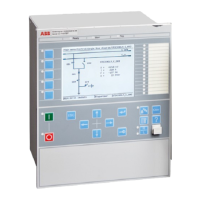2 = Remote 2,3,4,5,6
3 = Faulty 4,5,6
4 = Not in use 4,5,6
5 = All 1,2,3,4,5,6
6 = Station 2,4,5,6
7 = Remote 3,4,5,6
PSTO = All, then it is no priority between operator places. All operator places are allowed to
operate.
According to IEC61850 standard the
orCat
attribute in originator category are defined in Table
29
Table 29: orCat attribute according to IEC61850
Value Description
0 not-supported
1 bay-control
2 station-control
3 remote-control
4 automatic-bay
5 automatic-station
6 automatic-remote
7 maintenance
8 process
13.3.1.1 Bay control (QCBAY)
M16595-3 v7
The Bay control (QCBAY) is used to handle the selection of the operator place per bay. The
function gives permission to operate from two main types of locations either from Remote
(for example, control centre or station HMI) or from Local (local HMI on the IED) or from all
(Local and Remote). The Local/Remote switch position can also be set to Off, which means no
operator place selected that is, operation is not possible either from local or from remote.
For IEC 61850-8-1 communication, the Bay Control function can be set to discriminate between
commands with orCat station and remote (2 and 3). The selection is then done through the
IEC61850-8-1 edition 2 command LocSta.
QCBAY also provides blocking functions that can be distributed to different apparatuses
within the bay. There are two different blocking alternatives:
• Blocking of update of positions
• Blocking of commands
1MRK 511 358-UEN A Section 13
Control
259
Application manual

